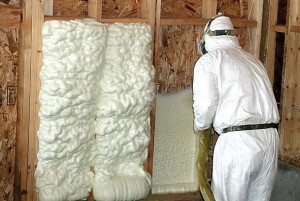Spray Foam
Spray Foam
Spray Foam expertise is in demand and AcEco can help. Our partnerships with manufacturers and contractors, combined with our
knowledgeable staff makes us your spray foam expert.
With today’s rising energy costs, focus on green building and sustainability, it’s no surprise more and more builders are using spray
polyurethane foam.
Green Building with Spray Foam
How would you like to leave a smaller carbon footprint? Use fewer resources to heat and cool your home? You can do both when
you choose to insulate your structure with Spray Foam products. When insulating with Spray Foam, you virtually eliminate the areas
where energy and dollars are escaping from, thus using less resources to maintain a comfortable living environment for you and your
family.
Whether you’re building your dream home, retirement escape, office or agricultural building, our Spray Foam is the right building
insulation.
We at AcEco use two different types of foam.
Open Cell
Open-cell polyurethane spray foam, is usually found in densities ranging from 0.4 to 1.2 lbs./ft3. One of the advantages that these lower densities provide is a more economical yield, since foam density is directly related to yield (lower density = higher yield). Although the R-value of open-cell foams is slightly more than half that of closed-cell foams, usually around 3.5 per inch, these products can still provide excellent thermal insulating and air barrier properties.. Open cell foam is more permeable to moisture vapor, with perm ratings of approximately 10.0 per 4 – 5 inches thickness (up to 50 perms at one inch). However, the foam allows for a very controlled diffusion of moisture vapor whose consistency can be managed by the builder / architect. Open cell foams are incredibly effective as a sound barrier, having about twice the sound resistance in normal frequency ranges as closed-cell foam. Other characteristics of open-cell polyurethane foam usually include a softer, “spongier” appearance, as well as lower strength and rigidity than closed-cell foams.
Closed Cell

Closed-cell polyurethane spray foam is among the most efficient insulating materials commercially available, with R-values commonly around 6.0 per inch.. Closed-cell foam incorporates an insulating gas that is retained within the cells (foam “blowing agent”), which leads to the highly efficient insulating properties of the material. In the U.S., insulation is measured in “R-Value” (R= resistance to heat flow), and closed-cell polyurethane spray foam has among the highest R-Values of any commercially available insulation. In addition, the closed-cell nature of this foam provides for a highly effective air barrier, low moisture vapor permeability (often referred to as the “Perm” rating), and excellent resistance to water . The most common foam density for closed-cell polyurethane foam is approximately 2.0 pounds per cubic feet. Years of research and commercial experience has shown that the 1.75 – 2.25 lb./ft3 density range provides the optimum insulating and strength characteristics for most building applications. Closed-cell polyurethane foams are usually characterized by their rigidity and strength, in addition to the high R-Value. Also, studies show that wall racking strength can by doubled or tripled when closed cell foam is applied.

